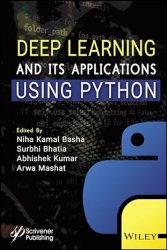Deep Learning and its Applications using Python
- Добавил: literator
- Дата: 5-10-2023, 01:58
- Комментариев: 0
 Название: Deep Learning and its Applications using Python
Название: Deep Learning and its Applications using PythonАвтор: Niha Kamal Basha, Surbhi Bhatia Khan, Abhishek Kumar
Издательство: Wiley-Scrivener
Год: 2023
Страниц: 255
Язык: английский
Формат: pdf (true), epub
Размер: 20.5 MB
Research into Deep Learning has come a long way across multiple domains, such as healthcare, marketing, banking, manufacturing, education, and so on. Notable applications within these domains are trending, like visual recognition, fraud detection, virtual assistance, NLP, etc. Deep Learning models are used to implement these applications. Those models include Convolutional Neural Network (CNN), Recurrent Neural Network (RNN), Long Short-Term Memory (LSTM), and others. To deploy these application-based Deep Learning models, Python programing is ideal, with its open source software libraries like Keras, Tensorflow, and soon.
This book thoroughly explains Deep Learning models and how to use Python programming to implement them in applications such as NLP, face detection, face recognition, face analysis, and virtual assistance (chatbot, machine translation, etc.). This book provides hands-on guidance to using Python for implementing Deep Learning application models. It also identifies future research directions for Deep Learning.
Chapter 1 deals with the history of Deep Learning. The origin tracks back to 1943, when Walter Pitts and Warren McCulloch computed a model (computer model) that supported the human brain (the neural networks). To mimic the thought processes of humans, Pitts and McCulloch used a collection of algorithms and arithmetic concepts, called threshold logic. Since then, deep learning has continuously evolved.
TensorFlow and Keras play a major role in the implementation of Deep Learning models. Therefore, Chapter 2 explains TensorFlow fundamentals, based on a Deep Learning framework. TensorFlow plays a major role in pattern recognition, specifically in regards to language, images, sound, and time-series data. Classification, prediction, clustering, and feature extraction occurs, too, with the help of deep learning.
Chapter 3 explains how a Python library called Keras has been used for deep learning. The chapter outlines the objective and focus of Keras to create neural networks layers and mathematical models. Chapter 4 continues the presentation of intelligent learning algorithms, explaining how multilayer perceptron is one of the supervised learning algorithms and is an example of artificial neural network with a feedback loop. Among other deep learning models, Chapter 5 delves into CNN algorithms, which act as an artificial neuron (neural network). This neural network is widely used to deal with image input for image processing, recognition, and classification.
Contents:
Скачать Deep Learning and its Applications using Python
Внимание
Уважаемый посетитель, Вы зашли на сайт как незарегистрированный пользователь.
Мы рекомендуем Вам зарегистрироваться либо войти на сайт под своим именем.
Уважаемый посетитель, Вы зашли на сайт как незарегистрированный пользователь.
Мы рекомендуем Вам зарегистрироваться либо войти на сайт под своим именем.
Информация
Посетители, находящиеся в группе Гости, не могут оставлять комментарии к данной публикации.
Посетители, находящиеся в группе Гости, не могут оставлять комментарии к данной публикации.

